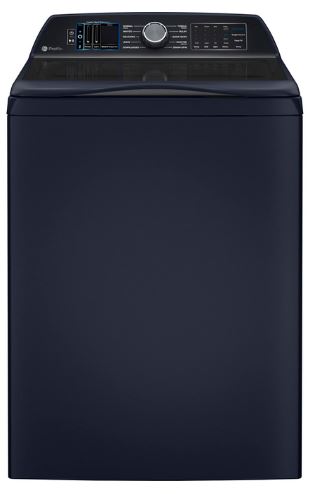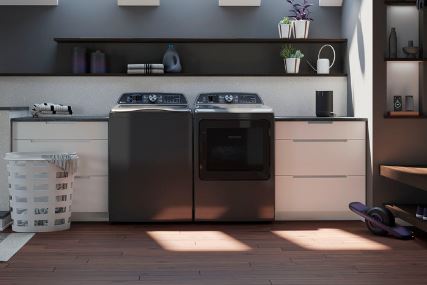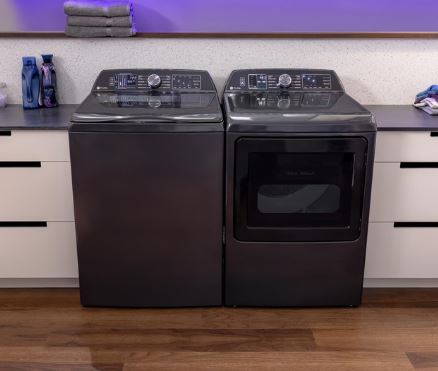GE Deep Fill washers are known for their cleaning prowess and energy-efficient abilities. However, they also malfunction, necessitating the need to keep your GE Deep Fill washer troubleshooting guide close by.
You can troubleshoot a GE Deep Fill washer that won’t start, drain, fill, or spin. Even better, you can also fix a GE Deep Fill washer that gets stuck in sensing mode or one that stops mid-cycle.
This guide will help you solve all the above issues. In addition, it will also help you reset your washer when you can’t figure out the problem, explain how to enter test mode to find some error codes to troubleshoot and bring your washer back to normal operations.
Here we go!
Are you in a rush? Below are the six common problems with a GE Deep Fill washer, their probable causes, and quick fixes.

Quick DIY GE Deep Fill Washer Troubleshooting Guide
| – | Problem | Probable Cause | Quick Fix |
| 1. | The washer won’t start | Power outage, unlatched door, washer switch button off, active lock controls, tripped breaker, or blown thermal fuse | Wait for power to be back on, latch the door completely, turn on the washer switch button, deactivate all lock controls, and replace the breaker or fuse if faulty |
| 2. | The washer won’t drain | Clogged drain hose, faulty drain pump, extended drain pipe height, faulty lid switch, load imbalance | Unclog the drain hose and pump, use a sump pump if the drain height is above 8 feet, replace the lid switch, and redistribute the laundry |
| 3. | Washer won’t fill | Faulty water inlet valve or low water pressure | Replace the water valve and raise the water pressure to 120 psi |
| 4. | The washer won’t spin | Load imbalance, clogged drain pump, unleveled washer, low water temperature | Redistribute the laundry, unclog the drain pump, level the washer on flat ground, and raise the water temperature to 140 degrees Fahrenheit. |
| 5. | The washer stays on sensing | Faulty component, faulty drainage system | Check the faulty component and replace it. Also, check the drainage system and unclog it if clogged and replace any part that’s damaged |
| 6. | Washer stops mid-cycle | Faulty inlet valve, unlatched door | Replace the defective inlet valve and latch the lid completely |
Typical GE Deep Fill Washer Problems
Below are the six common issues with a GE Deep Fill washer and their quick fixes.
1. GE Deep Fill Washer Won’t Start
If your GE Deep Fill washer fails to start, below are the probable reasons to explain why:
- Power outage – The first check to make is to check the power. You can switch on the light to check if it lights up. If there’s an outage, the bulb won’t light, nor will your washer start.
- Unlatched lid – Your GE Deep Fill washer has a sensor that detects when the lid is open. If the lid isn’t engaged correctly, your washer won’t start.
- Washer switch button could be off – Your GE Deep Fill washer has a switch button that you need to turn on to start it. If the button is off, no cycle will begin.
- Active lock controls – When the lock controls like Control Lock or Child Lock functions are on, they lock all your washer functioning, thus disallowing your washer from starting.
- Tripped breaker or blown thermal fuse – If there was a recent power surge, the breaker or fuse could have blown away, which explains why your washer won’t start a wash cycle.
Quick Fix
In an outage, wait for the power to be back, ensure you latch the lid properly, and remember to switch on the washer button.
If the lock controls are on, turn them off to unlock your washer, use a multimeter to test the continuity of the fuse and breaker, and replace the faulty part.
2. GE Deep Fill Washer Won’t Drain
Your GE Deep Fill washer drains several times during each wash cycle. If your washer doesn’t drain, it could be due to the following reasons:
- Clogged drain hose – If the hose has kinks, damages, or is clogged, wastewater won’t drain through it or may do it slowly.
- Faulty drain pump – If the hose is fine, the next culprit is the drain pump. It could have cracks or clogs.
- Extended drain pipe height – The pipe should be at least 8 feet long. If it’s extended, that explains why your GE Deep Fill washer isn’t draining.
- Faulty lid switch – The lid switch detects if the washer lid engages correctly. If the lid switch is defective, it doesn’t signal the washer to start spinning. If spinning doesn’t take effect, then draining won’t be so.
- Unbalanced load – If your washer drains slowly, the explanation could be that there is a load imbalance. If there is no laundry distribution in the washer, spinning will be slow, and the draining will be slower.
Quick Fix
Unclog the drain hose and pump in case of clogging or replace them if damaged. If the drain height is above 8 feet long, use a sump pump to help pump water out of your washer.
Replace a defective lid switch and redistribute the load for evenness, flawless spinning, and draining.

3. GE Deep Fill Washer Won’t Fill
If water doesn’t fill your GE Deep Fill washer, the wash cycle won’t start. Below are some explanations as to why your washer fails to fill with water:
- Faulty water inlet – This valve allows water to flow to your washer. If it’s clogged, kinked, or defective, it hinders water from flowing to the washer, explaining why it fails to fill with water.
- Low water pressure – For efficient water flow to your washer, your in-home water pressure should be at least 120 psi. If the washer pressure is below 20 psi, it explains why your washer doesn’t fill.
Quick Fix
Check the inlet valve for kinks or bends and straighten it. If it’s damaged or faulty, replace it. Also, check your home water pressure using a pressure gauge and raise it to at least 120 psi.
4. GE Deep Fill Washer Not Spinning
Several reasons can explain why your GE Deep Fill washer isn’t spinning. Below are some of them:
- Load issues – If there is an overload, underload, or uneven load, your washer will struggle to spin or may fail to spin altogether.
- Clogged drain pump – Two functions run simultaneously, spinning and draining. If the drain pump is dirt-clogged or damaged, it may drain slowly. If draining doesn’t take full effect, then the turning may be in jeopardy.
- Unlevelled washer – Another reason your GE Deep Fill washer fails to spin is the washer not being on level. If you notice your washer vibrating violently, it could be unlevelled, and that’s why it doesn’t turn.
- Low water temperature – Maybe you don’t know this, but too cold or freezing water could make your washer not spin.
Quick Fix
Redistribute your laundry in case of an uneven load, but if there’s an overload, remove some clothes and add more up to 3 ⁄ 4 full in case of an underload.
Check the drain pump for clogging and use a drain snake to unclog it. If the washer is not on level, use a print lever to tilt its legs until they touch the ground and ensure your water temperature is at least 140 degrees Fahrenheit.
5. GE Deep Fill Washer Stuck On Sensing
What a shame for your washer to stick on sensing. But why is your GE Deep Fill washer sticking on sensing mode? Find the reason below:
- A faulty component – If there is a defective component like the water inlet valve, transmission, control board, or shift actuator, your washer will likely get stuck in sensing mode.
- Faulty drainage system – An issue in the drainage system, like the drain valve, drain hose, or pump, clogging or damage, makes your washer stick to sensing mode.
Quick Fix
Check for any faulty washer components, starting with the ones listed above, and replace the defective part. Also, check the drainage system and clean it to be free from any blockage.

6. GE Deep Fill Washer Stops Mid-Cycle
If your washer starts but fails to complete a wash cycle, below are some possible explanations:
- Faulty inlet valve – The inlet valve ensures a steady water flow to your washer when needed. Insufficient water will flow to your washer if it’s clogged or defective. Once the washer starts a cycle but detects low water, it stops mid-cycle without a doubt.
- Unlatched door – If you open your washer when running and fail to close the lid correctly, the lid switch detects the unclosing lid, and thus your washer stops halfway.
Quick Fix
Unclog and clean a clogged inlet valve. If faulty, replace it and ensure you latch the washer lid correctly.
GE Deep Fill Washer Reset
Resetting your GE Deep Fill washer if you paused the cycle is advisable. You can also reset your GE Deep Fill washer if there is an interruption due to power failure.
Since GE Deep Fill washers lack a dedicated reset button, below are the easy steps to follow:
- Unplug the washer from power or shut off the fuse or breaker
- Wait for about 2 minutes and plug it back
However, if your GE Deep Fill washer model has a timer control knob, turn the knob around and back to a position other than the initial one and restore the power.
GE Deep Fill Washer Error Codes
GE Deep Fill washer displays an error when something is amiss. Knowing the error and its meaning helps in fixing the issues. But how do you find GE Deep Fill error codes? Below are the steps to follow:
- Press and hold the power button until the display panel goes off
- Unplug the washer cable from power for at least 30 seconds
- Plug the cord back to power and press signal, start, signal, and start relay in the same order (this allows the washer to enter test mode)
- Wait for a few seconds for it to display T01 to show it has entered test mode
- Press delay start to enable the washer to indicate the error code
- View the error, write it down, and clear it by pressing start/pause
- Lastly, to exit test mode, press signal, delay start, signal, and delay start one more time
But how do you know the meaning of the error code? Well, below is a table with the error codes and their meaning:
| Error Code | Meaning |
| LO | Open lid |
| E70 | Stuck key |
| E71 or UB | Unbalanced load |
| DR/E30 | Drainage issues |
| E23 | Overfill |
| E22 | Slow or no fill |
| E46 | Overheated motor |
| E57/E58 | A defective main control board |
Closing Thought On GE Deep Fill Washer Troubleshooting
Above is a detailed GE Deep Fill washer troubleshooting manual when your washer doesn’t start, fill, drain, spin, sense, or stop mid-cycle.
Since you can troubleshoot the issues yourself, you save on the expensive technician cost. However, if you cannot pinpoint the problem, you can quickly reset your washer or enter diagnostic (test mode) to find out the issue and fix it ASAP.
